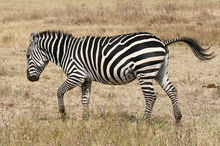Summer is synonymous with biting flies and the bloody trail their bites leave behind are not only painful to see on the animals we love, but leave wounds open to infection.

Zebra stripes - Unattractive to horse flies
Discovering that different coat colors reflected different light waves influencing fly attraction prompted new questions: What kind of light would bounce off the striped body of a zebra and how would that affect biting flies?.
© 2015 by Muhammad Mahdi Karim
According to a 2013 report in Journal of Experimental Biology by Hungarian and Swedish researchers, including Susanne Akesson of Lund University, zebras may have evolved striped coat patterns to make themselves âunattractiveâ to biting flies.
Akesson said the study, which initially looked at the relationship between horses with brown, black or white coats and tabanids (horseflies), found that, âIn black and brown horses, we got horizontally polarized (reflected) light.â Meaning, light moved in waves along a horizontal plane and flies were highly attracted to these âflatâ waves.
In comparison, the researchers found white coats delivered unpolarized light waves, which traveled in multiple directions and were less appealing to flies.
Discovering that different coat colors reflected different light waves influencing fly attraction prompted new questions: What kind of light would bounce off the striped body of a zebra and how would that affect biting flies?
Placing four life-size, 3-D horse models in a field â one brown, one black, one white, and one zebra-striped â their results showed that a striped horse attracted the fewest flies.
We can't always paint stripes on our horses but can protect sensitive legs from biting flies with Silver Whinnys ⢠(aka Summer Whinnys ®), the pull-on equine leg wear by Sox For Horses, Inc. with anti-microbial silver yarn to support a clean, dry, 'breathing' environment and unique design to cover the parts of the leg and hoof most vulnerable to infection and typically unprotected by other fly protection products.
Ray Petterson, president of Sox For Horses, Inc., one of the first companies to bring antimicrobial products to the equine world, says, âHorses can encounter bacteria, dirt and disease under many outdoor conditions, including through biting insects. It is one thing to offer a fly barrier for horse legs, but once I knew silver ion-embedded yarn was available and functional in such environments, it was common sense to start using it.â
And easier than DIY zebra sheets, Petterson chuckles: âI took a cheap fly sheet that Tem, our Quarter Horse, could not wear because it was too hot, modified it to cover his neck and shoulders, and painted it with zebra stripes. He liked it. He looked mighty silly as half a zebra but that, plus his Summer Whinnys, made a difference.â
About Sox For Horses
Sox For Horses, Inc. (SFHs) is the first company to bring antimicrobial yarn solutions to the equine horsewear industry. The Sox For Horses, Inc. mission is to help owners, trainers and veterinarians better help equines by providing exceptional leg protection with high levels of quality, function and durability, through optimal use of cutting-edge yarn science.
Through growth and opportunity, Sox For Horses, Inc. makes a difference in the lives of people and animals, supporting equine and animal rescue organizations while adding jobs in American manufacturing. Whinny Warmers® with Celiant® and Silver Whinnys⢠(also known as Summer Whinnys® Silver) are Made In America. Visit www.soxforhorses.com or call Sox For Horses, Inc. (850) 907-5724 to find the socks to fit your horse.
